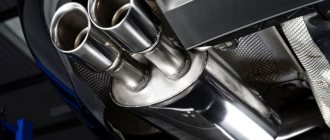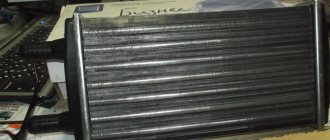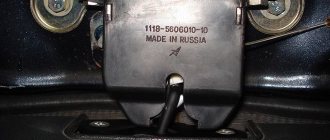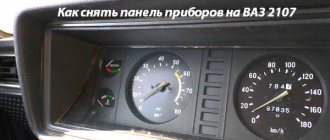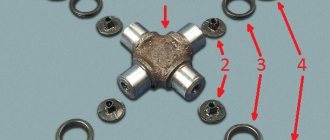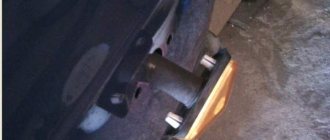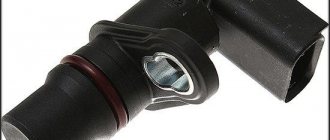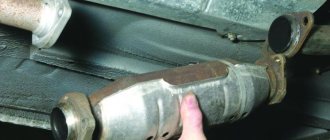The VAZ 2107 is a legendary car, one might say. Firstly, this is the last representative of the VAZ classic, and secondly, it is a car in which both a carburetor and an injector were used to supply fuel. Today, the last cars of this brand that came off the assembly line still work properly. The only weak point of perhaps one of the most famous cars is not very good hardware. The VAZ 2107 injector tin is very susceptible to corrosion. Due to this very unpleasant feature, the gas tank can also develop an unexpected leak.
So that you are always prepared for such situations, in this article we will briefly go over the design features of the VAZ 2107 gas tank with an injector system. Let's talk about how to dismantle the fuel tank yourself and how to repair it both in an emergency and in a normal situation.
Gas tank on VAZ 2107
Design features of the VAZ 2107 gas tank
The design of a VAZ 2107 gas tank with a classic pure water injector system. The entire VAZ family, from the seven to the kopeck, has exactly the same fuel tanks. The actual gas tank of the VAZ 2107 has a volume of just over 40 liters, with about three or four more going into its neck . That is, in fact, a full refueling of the seven is about 45 liters of fuel. However, the main thing is that if your car is already quite old, the condition of the fuel tank must be strictly monitored, otherwise it is fraught with very unpleasant consequences.
Vehicle specifications
Already at the development stage, the manufacturer determines the parameters of the machine, which are refined during the testing process. So, in the described car, model VAZ 2107, the volume of the fuel tank corresponds to the size of the niche in the trunk behind the right wheel arch. Crankcases of other mechanisms contain the following quantities of operating fluids:
- engine – 3.75 liters of engine oil;
- cooling jackets, radiator and expansion tank - 9.85 liters of antifreeze;
- manual gearbox housing – 1.35 liters of TAD-17 oil;
- rear axle - 1.3 liters of the same oil;
- hydraulic clutch – 0.2 l of brake fluid;
- steering gear housing – 0.215 l of hypoid oil;
- closed container for windshield washer - 2 liters of water or special liquid.
Operating standards for the VAZ 2107 car were developed by the manufacturer for organizations and enterprises. Knowing the volume of fuel that the tank or crankcases of other mechanisms hold, it is easy to calculate the amount required for travel.
The VAZ 21074 is made in a sedan body - both in the opinion of the plant’s designers and in the opinion of car enthusiasts, a sedan is the most convenient “box” for both personal use and for cargo transportation.
It is worth noting that the carrying capacity of the machine indicated in the technical documents (1430 kg) is underestimated. Surely you have more than once seen a “four” loaded to maximum, on which neighbors were transporting things or bags of potatoes. Until now, in any market, a fairly large number of sellers use the VAZ 21074 to transport goods. Do not forget that initially the model was not created for the transportation of goods in principle!
The carburetor mechanism in the VAZ 21074 is two-chamber, emulsion
How to detect a leaking gas tank
There is no need to worry about noticing a leaking gas tank. If gasoline escapes from the fuel tank, this will be accompanied by the following symptoms:
- Significant increase in fuel consumption. It’s hard not to notice that gas is running out, even if the car is parked.
- There will be a distinct smell of gasoline inside the car.
- Rainbow spots will remain on the asphalt where your VAZ 2107 was parked.
If at least one of the above signs occurs, most likely, your VAZ 2107 with an injector system actually has a leak in the gas tank. There are several options for action in this situation; we will divide them into emergency and planned.
Emergency gas tank repair
If your car’s gas tank leaks on the highway and you can’t get to the nearest car service center without repairs, you can use a few tricks that will help temporarily return the fuel tank to operation.
The simplest and most effective way: seal the gas tank with rubber or plastic. For this we need:
- Superglue or ordinary glue moment.
- A piece of rubber from a tire or a plastic bottle.
So, the first thing you need to do is find the place where the gas tank is damaged, where fuel is escaping. In the case of the VAZ 2107, the injector system is leaking most likely from below; its cause is a hole or corrosion damage. As soon as the damage is detected, we proceed as follows: cut out a piece of rubber or plastic, lubricate it with glue and press firmly against the damage. After a few minutes you can release the patch, it will finally set in a couple of hours, but in any case you can go. You can easily get to a car service center with such a patch; there are cases when car enthusiasts drove with it for several weeks.
Fuel tank VAZ 2107
Another way to seal a hole is with a regular self-tapping screw. Suitable if the damage is small in diameter and you have a rubber seal for the screw. This is done as follows:
- First you need to find the location of the damage.
- Then install the seal on it (a regular piece of a car inner tube will do).
- Screw a self-tapping screw into the seal so that it fits into the gap in the gas tank and plugs it.
It will be possible to get to a car service center with such a simple repair. Moreover, it is better to stop at the first one you come across; the design is extremely unreliable and can fail at any moment.
Scheduled repair of the gas tank
If you notice a leak and decide to fix it with your own hands, the first thing you need to do is dismantle the VAZ 2107 gas tank; the process is similar for both the carburetor and a car with an injector system.
Main malfunctions of the fuel injection system and their symptoms
Before moving on to malfunctions of the “Seven” fuel system, let’s consider what symptoms may accompany them. Signs of a system malfunction include:
- difficult starting of a cold power unit;
- Unstable engine operation at idle speed;
- “floating” engine speed;
- loss of engine power;
- increased fuel consumption.
Naturally, similar symptoms can occur with other engine malfunctions, especially those related to the ignition system. In addition, each of them can simultaneously indicate several types of breakdowns. Therefore, when conducting diagnostics, an integrated approach is important here.
Difficulty starting when cold
Problems with starting a cold unit can occur when:
- fuel pump malfunction;
- reducing the throughput of the secondary filter;
- clogged injectors;
- failure of the lambda probe.
Unstable motor operation without load
Irregular engine operation at idle may indicate:
- malfunction of the XX regulator;
- fuel pump failure;
- clogged injectors.
"Floating" speed
Slow movement of the tachometer needle, first in one direction, then in the other, may be a sign of:
- malfunction of the idle speed sensor;
- failure of the air flow sensor or throttle position sensor;
- malfunctions in the fuel pressure regulator.
Power Loss
The power unit of the injection “seven” becomes significantly weaker, especially under load, with:
- malfunctions in the operation of the injectors (when fuel is not injected into the manifold, but flows, as a result of which the mixture becomes too rich, and the engine “chokes” when the gas pedal is sharply pressed);
- failure of the throttle position sensor;
- interruptions in the operation of the fuel pump.
All of the above malfunctions are accompanied by an increase in fuel consumption.
Dismantling the gas tank
- So, first we remove the plastic casing under which the gas tank is hidden. It is secured with screws that can be unscrewed with a Phillips screwdriver.
- Now disconnect the power wires from the fuel sensor. You can simply pull them up and remove them from the contacts.
- Next, unscrew the fastening of the fuel hose and pull it out of place using pliers.
- Then unscrew the bolt of the clamping plate securing the VAZ 2107 gas tank with the injector system.
- Now you can unscrew the filler cap and carefully remove the gas tank.
Next, all that remains is to seal the gap in the gas tank. There are many repair methods, from cold welding to sealing the tank with tar. Let's take the simplest and least expensive path.
Possibilities for upgrading the machine
In the nineties of the last century, many owners of VAZ 2107 cars, not particularly counting on gas stations, installed an additional tank in the car. This is much more convenient than pouring fuel from cans. Typically, such a container was located behind the rear seat in the trunk. It could have different sizes, and accordingly they had the appropriate capacity.
The driver in those days often encountered empty gas stations, and the additional volume of the fuel tank greatly expanded the capabilities of the car. Knowing the required amount of technical fluids is necessary for routine maintenance of the engine and other systems.
Seal the gas tank
So, first of all, we go to a specialized store; to repair the gas tank we will need:
- Fiberglass.
- Epoxy resin.
- Sanding paper.
- Acetone.
It is very important, before starting to repair a gas tank, to thoroughly dry the fuel container and degrease it; the final result depends on this. Next, cut the fiberglass into pieces so that they are larger than the area of damage. Impregnate the fiberglass with epoxy resin.
Place fiberglass cloth on the surface so that there are no bubbles; excess resin should be removed. Pay special attention to the first layer; the final result depends on its quality.
After the repair is completed, let the patch dry, then be sure to putty and paint the gas tank, this will increase the reliability of the repair.
This way you can inexpensively repair your gas tank. However, even this is not a panacea; such a patch will only last for a few years at most, and besides, it, of course, will not stop the corrosion processes of the fuel tank. Therefore, the ideal solution is to purchase a new gas tank. Moreover, on a VAZ 2107 with an injector system this part today costs no more than 3 thousand rubles.
VAZ-2107 is one of the representatives of the legendary classic models. It used both types of fuel supply systems. Both injection and carburetor models were produced. Even those copies that were the last to leave the assembly line still work properly. The only weak point of this car is the hardware. For this reason, it is extremely important to know the exact volume of the gas tank of a VAZ-2107 car, because due to corrosion it can give a small leak, which you will be able to notice only when you control the amount of fuel poured in.
Chevrolet Niva tank design
The gas tank is a welded structure made of sheet steel. This provides it with sufficient strength and safety. Steel is well welded and soldered. This makes it possible to eliminate minor damage to the walls. However, when condensation forms, the internal surface becomes corroded, creating the risk of rust entering the fuel system. Initially, the Niva Chevrolet was equipped with gas tanks manufactured by General Motors. Their factory part number is GM 212301101011000.
Advice: on the spare parts market, tanks made at AvtoVAZ are more often found. Their quality is not inferior to the original ones, and the price starts from 8,000 rubles.
Leak detection methods
If you notice that gasoline is consumed very quickly, there may be several reasons: from difficult road conditions (mud roads, traffic jams) to a leaking gas tank. A faulty fuel tank can be determined by several signs:
- there is less gasoline even if you don’t use it;
- there was a smell of fuel in the cabin;
- at the place where the VAZ-2107 stood for some time, rainbow spots appeared on the ground or asphalt.
If you notice at least one of the signs, you need to check the fuel container for leaks.
About the fuel pump on the VAZ2107 injector
If the car engine does not start, then various factors can be the reasons for such consequences. One of these factors may be a gas pump, the main purpose of which is to pump gasoline into the engine from the gas tank. The VAZ 2107 has an injector and a fuel pump that is much more reliable than on carburetor cars. Despite this, even on fuel-injected cars the fuel pump can fail.
Repair with improvised means
If you are away from a garage or home where you have the necessary tools to remove the tank, you can carry out emergency repair work. For this you will need to have on hand; “Moment” glue or any other composition for rubber or plastic; a piece of tire, thin rubber or plastic bottle.
Look for a leak on the fuel tank; most often it is located at the bottom, since the tank is corroded by moisture or holes. Glue the patch to this place, hold it for a few minutes and leave for 2-3 hours until the composition has completely set. After such repairs, you will easily get to the nearest service station. There have been cases where motorists used a tank patched on the road for up to several weeks, but you should hurry up with major repairs, as sometimes patches do not help.
For the second emergency repair option, you will need to have a self-tapping screw on hand. If the diameter of the hole in the tank is small, then it is advisable to screw a simple self-tapping screw into it with a rubber or neoprene washer put on it. You can make your own washer from a piece of rubber bladder. In this case, screw the screw directly through the small rubber flap.
Remember that any of the described repair methods is a temporary measure. Stop at the nearest car service center so as not to encounter a more global problem while traveling or away from populated areas if you often go on intercity trips.
Penalty for draining fuel
Of course, fuel theft occurs not only in large enterprises and by drivers who are responsible for the car. Most often, the victims are ordinary car owners who leave their vehicles in the courtyard of their house. Every thief knows perfectly well how to drain gasoline with a hose quietly at night so that no one notices, and the absence of an alarm simplifies theft. Such criminals can be punished as follows:
- If the thief is caught, he faces a fine of 80,000 rubles. The fine will be paid by confiscating the person’s income for a period of six months.
- The court may award correctional labor for 360 hours.
- The offender can be imprisoned for four months, and in particularly difficult cases - for two years.
If the theft is committed by a group of people, and they illegally enter the premises where the car is parked, for example, a garage or a closed yard, then the punishment may be as follows:
- The fine automatically increases to 200,000 rubles.
- Compulsory labor for each thief will be 480 hours, and sometimes correctional labor can last for two years.
- Forced detention for a year and correctional labor for up to 5 years are applied.
Particular attention should be paid to theft of fuel from an oil pipeline on an especially large scale, in which case the punishment will be especially severe. The fine increases to 500,000 rubles, and the term of imprisonment will be at least six years
When wondering whether it is possible to drain gasoline from a car and go unpunished, first of all you need to understand that any theft will sooner or later be discovered, regardless of the size of the crime. Petty theft can result in imprisonment for 15 days, and larger theft can result in imprisonment for up to 10 years.
Replacement of gas tank and major repairs
Regardless of what type of fuel injection is used on your vehicle, the process for removing the tank will be the same. First drain all fuel from it. Next, carry out the following work:
- Remove the plastic casing from the container. To do this, you will need to unscrew several screws using a Phillips screwdriver.
- Disconnect the wires from the contacts leading to the fuel sensor.
- Use pliers to pry off the fuel hose.
- Unscrew the bolt of the tension plate that secures the gas tank.
- Remove the cap from the neck and carefully remove the tank.
Assess its condition. If there are several leaks or they are too large, then it will be easier to replace the entire fuel container. To do this, simply take a new tank and reassemble it in the reverse order.
Description of the salon
By modern standards, the exterior of the VAZ 21074 is outdated.
Due to the fact that the entire line of the VAZ 2107 family (and the VAZ 21074 is no exception here) is rear-wheel drive, the engine is located in front, which made it possible to significantly expand the interior space: both in the ceiling and in the legs for the driver and front row passenger.
Compared to previous versions of the VAZ, the 21074 is more spacious inside
The interior trim is made of special plastic alloys that do not give glare and are easy to maintain. The floor of the car is covered with polypropylene mats. The body pillars and the inner parts of the doors are covered with medium-hard plastic and covered with caprovelor on top. The seats in most cars are upholstered in durable, wear-resistant fabric - velutine.
It must also be said that the VAZ 21074 uses a large number of “auxiliary” materials for interior decoration - various types of mastics, bitumen gaskets, felt pads and lines. All these materials come into contact with the upholstery in one way or another (doors, bottom, seats) and protect the interior from excessive noise from the outside.
- increased cabin sound insulation;
- minimizing vibration waves while driving;
- protection of metal from rust;
- increasing the thermal insulation of the cabin.
High-quality plastic and durable velutine fabric are used to equip the interior.
Dashboard
VAZ 21074 is considered a more comfortable version of the VAZ 2107. Comfort is achieved in various ways, including making it easier to drive. Thus, the instrument panel allows the driver to see current data on both the ride and the condition of his “iron horse” at any time.
On the VAZ 21074, the dashboard is made up of many elements, each of which shows the operation of a particular unit in the car. The panel is embedded in the dashboard of the car on the driver's side. All elements are located under plastic glass: on the one hand, they are clearly visible, on the other, the devices will be protected from possible mechanical shocks.
The instrument panel is protected from external influences by a plastic visor and durable glass
The instrument panel of the VAZ 21074 contains the following elements:
- A speedometer is a special mechanism that shows the current speed. The scale is numbered in divisions from 0 to 180, where each division is the speed in kilometers per hour.
- Tachometer - located to the left of the speedometer and is used so that the driver can see the crankshaft rotation speed per minute.
- ECON fuel consumption gauge.
- Engine temperature indicator - for the VAZ 21074, the engine operating temperature is set in the range of 91–95 degrees. If the pointer needle “crawls” into the red zone of the device, the power unit is working at the limit of its capabilities.
- Fuel quantity indicator in the gas tank.
- Accumulator charging. If the battery light comes on, it is necessary to provide additional charging to the battery (the battery is discharged).
In addition, there are additional lights and indicators on the instrument panel that remain turned off during normal operation (for example, engine oil level, engine problems, high beam, etc.). The lights turn on only when there is a problem with a particular system or when a certain option is enabled.
Illuminated additional elements indicate errors, problems or the inclusion of an option
The gearbox on the VAZ 21074 operates according to the international standard. That is, the first four gears are switched on by analogy with the writing of the Russian letter “I”: up, down, up, down, and the fifth - to the right and forward. Reverse speed is switched to the right and backward.
Transmission
| Clutch | single-disk, dry, with hydraulic shutdown drive and central diaphragm spring |
| Transmission | mechanical, four- or five-speed, three-way, three-shaft, with synchronizers on all forward gears |
| Gear ratios: | |
| first | 3,67 |
| second | 2,10 |
| third | 1,36 |
| fourth | 1,0 |
| fifth | 0,82 |
| reverse | 3,53 |
| Cardan transmission | two-shaft, with intermediate support and elastic coupling |
| main gear | hypoid |
| Final drive ratio | gear ratio – 3.9 or 4.1 |
| Differential | conical, two-satellite |
History[ | ]
People's House, 1900s, photo by Maxim Dmitriev The resolution on organizing an opera house in the city was adopted by the City Council in 1931. It was decided to rebuild the building of the People's House into a theater. The People's House was built in 1903 on the initiative of the Society for the Promotion of Primary Education in the Nizhny Novgorod Province with the assistance of M. Gorky. It was conceived as a “center of culture” in the provincial town (club, library, amateur theater).
The building was built according to the design of the architect P. P. Malinovsky with private donations, large of which were made by Countess S. V. Panina and F. I. Chaliapin, who gave a concert in favor of the construction at Gorky’s request.
The State Commission signed the act of acceptance for operation of the rebuilt building on May 31, 1935, and on July 1 the tour of the Musical Theater began. V.I. Nemirovich-Danchenko, then the Leningrad Choir Chapel and the Kyiv Musical Comedy.
By October 24, 1935, the theater prepared its first performance - A. Borodin’s opera “Prince Igor”. It has become a tradition to open the season with this piece.
Opera theatre. 2022
The second performance in the repertoire was “Eugene Onegin”. In the first season, a fairly large troupe (45 opera soloists, 50 orchestral musicians, 53 ballet dancers, 57 choir artists) staged (except for those mentioned above) the operas “Aida”, “Rigoletto”, “The Tsar’s Bride”, “The Barber of Seville”, "Pagliacci", ballets "Don Quixote", "Swan Lake" and ballet divertissement.
The theater confidently declared itself
Spectator interest and public attention confirmed the historical necessity of opening the State Opera and Ballet Theater in Nizhny Novgorod. This “was the largest event in the musical life of the city in the 30s”
On February 10, 1937, the theater was named after A.S. Pushkin. In 1994 he received the title of “academic”.
In 1986, the First All-Russian Pushkin Festival of Opera and Ballet “Boldino Autumn” took place. Since the second festival, which took place in 1988, “Boldino Autumn” has been held annually.
In September 2022, the large-scale reconstruction of the theater, which began in June, was completed. The façade, auditorium and interior have been restored
How long will gasoline last if the light comes on? Also, why can’t you empty the tank?
The VAZ-2107 stove does not heat (carburetor, injector): reasons, repairs
Often it is the girls who ask me seemingly elementary questions, but they are important to them. One of these is how many kilometers will gasoline last if the light comes on. To be honest, I wanted to present this information for a long time, but from a slightly different side, namely, why shouldn’t you empty the car’s tank, that is, drive until it’s almost dry! In general, we read a lot of useful information...
To begin with, I would like to say that tanks have changed, they have evolved along with cars, and the point here is not in the metal tank itself (although they now have plastic ones), it’s all in its filling, namely in the method of supplying fuel.
How fuel is supplied
If we recall the recent past, namely carburetor engines, the tank often served as just a container for gasoline into which a tube was installed for pumping fuel into the system - it went to the very bottom, which made it possible to pump out fuel to the maximum. But the pumping was carried out using a special mechanical fuel pump; it had no electrical parts at all, and it received energy from the mechanical operation of the engine
The most important thing is that the fuel pump was located on the engine, remember this!
Much water has passed under the bridge since those times; now the design has changed dramatically.
Injectors and electronic fuel supply and ignition systems have become an integral part of our lives. Nowadays there is no longer a mechanical fuel pump - it is electric and is located in the tank, and not on the engine.
If you look at this solution, then they killed two birds with one stone - firstly, there are no long lines to the pump, and secondly, they removed the overheating of the electric motor by immersing it in gasoline - after all, it gets seriously hot during operation. Afterwards, it supplies fuel to the line, and only later to the fuel rail.
What does this icon mean and why is it lit?
The icon is made in the form of a gas station, so that it is clear that you need to go there. And it lights up red, or yellow, maybe even orange - because it signals danger, namely due to low fuel level. After a certain mileage you will simply stop, so it’s urgent to “fill up” the tank.
It should be noted that in modern cars, this seems to have a double meaning, not only about low fuel levels, but also about possible breakdowns, more on that below.
About the light bulb and tolerances
Many manufacturers indicate the fuel level in the operating instructions for the car, others in the specifications on websites or dealer networks. To be honest, there is simply no single norm! It all depends on the shape of the tank and its design, but there is an unspoken standard:
Usually there is about 5 - 7 liters of fuel left, and this is enough for about 50 - 60 kilometers. It all depends on the engine size and your driving style. I would also like to note that the more you allow your car to idle, the less mileage it will have. I think this is logical.
To be honest, I measured it on my car once (I simply don’t advise you to do more, you’ll understand why later) - I have about 60 kilometers. It is also worth noting that, purely structurally, there are, as it were, two divisions on the AVEO.
The first is when “LOW” is written, one stick on the tank scale lights up, then it will last for about 70 km.
The second is when the “lamp” also lights up - then it remains for 50 kilometers.
By the way, on many cars, the inscription may light up, and not the gas station icon.
Why shouldn't you let the tank empty?
The fuel level drops, the pump tries hard to pump in the remains, its body is completely exposed and begins to heat up. This has a very negative effect on it; if you like, such overheating can cause its failure.
Remember a simple truth - do not reach a dry tank! This negatively affects the fuel pump. As soon as the light comes on, you need to immediately go to the gas station and fill up with fuel.
In a good way, make it a rule not to even reach the lamp; as soon as the fuel level has dropped, but the lamp is not yet on, we go to the gas station. Thus, the pump will always be in gasoline and cool properly.
Now we are watching a short video.
Didn't find the information you are looking for? on our forum.
We recommend reading:
Storage of motor oil, expiration dates, regulations
Totachi engine oil 10w40
Shell hx8 5w40 engine oil reviews, specifications
Idumitsu engine oil 5w30, characteristics
Motor oil zic x9 ls diesel. Description, where used, characteristics
Black smoke from the exhaust pipe, gasoline or carburetor
Checking gasoline for octane number, how and with what they check fuel
How to clean your windshield from grease stains
Checking the valve with a multimeter
Diagnostics can also be done with a voltmeter. How to check the fuel canister check valve? You need to open the hood and disconnect the wiring harness connector from the valve. Next, connect the negative probe of the multimeter to ground and turn on the ignition. Then bring the positive probe to the wire chip and look at the values of the device. The readings should not be lower than 12 V.
To inspect the valve itself, loosen the hose clamp with a screwdriver and remove the tube outward. Next you need to remove the valve itself by prying it off with a slotted screwdriver. It is necessary to turn on the ignition and apply “plus” and “minus” to the corresponding terminals on the element. If the valve is working properly, you will hear a characteristic click. Otherwise, the element is defective and must be replaced. The cost of a new element is 350 - 370 rubles (suitable for a VAZ of the tenth family).
To replace the valve, you only need a slotted screwdriver. She needs to unscrew the clamps of the gasoline hoses and pry off the edges of the element. The new one must be installed tightly into the grooves until it clicks. Next, put the hoses on the valve and tighten the clamps. At this point, the replacement of the Semyorka adsorber valve has been successfully completed.
Canister valve
This element is installed on all car injectors, and the “Seven” was no exception. What is this element? The adsorber valve is a kind of can installed in the engine compartment near the air filter and filled with activated carbon. What is it for? The adsorber valve on the Semerka serves to condense and absorb gasoline vapors. When fuel vapor evaporates, it turns back into liquid and is sent back to the engine power system.
How to check this element? The main sign of a malfunction is the accumulation of gasoline vapors and a pungent odor in the cabin. The problem is also accompanied by dips at idle and loss of power during acceleration. If the tank hisses when opening, it means that the adsorber valve has become unusable. It is not necessary to change the entire jar - just one valve is enough. After replacement, the car works properly again, and strong odors no longer penetrate the interior.
